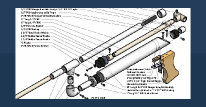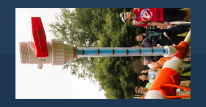I'm very new to all this; I've been lurking a lot, and I learned so much. As a thank you, I want to share a method I recently developed as part of my project to build a NERF loser rifle from scratch for Humans vs. Zombies at my university. I needed very precisely calibrated darts, that are not only accurate and long-flying, but also very consistent in their performance.
Herein, I'll tell you how to make your darts fit any barrel bore-size perfectly. As long as the darts are no more than 0.050" larger than the bore-size, this method should work. Additionally, the darts will form a wonderfully smooth, hard surface - very good for shooting!
If your darts are smaller than your bore-size, this method will not work. Try putting your darts into the dryer for longer than usual. Maybe they'll expand enough to fit comfortably. But I cannot guarantee that, since I haven't tried it myself. Careful, they might melt. Anyway, disclaimer over, on to the show!
Materials you'll need:
- 3" metal tubing that has an ID (inner diameter) which is the same as your intended diameter for your darts. We'll call this piece of metal tubing the dart template. I recommend that the ID of the dart template be no more than 0.010" smaller than the ID of the barrel, but definitely not bigger than the barrel ID. The tightness of the fit should depend on whether you are working on an air gun or a spring gun. Spring guns should be tighter, so that there is more friction to hold the dart in place while the plunger builds up air pressure. Air guns should be looser - but I think a 0.027" difference in ID between the dart template and the barrel is too loose. So there'll be some experimentation on your part. We're looking for perfection here, afterall! As for the 3" length, simply make sure that the tubing is 1-2" more than the dart length.
- FBR darts - Stefans assumed. For a guide on making Stefans, click here. Now, my recommendation: expand the FBR using a clothes dryer (about 8-10 min). Don't use a hair dryer, and I can't guarantee that my method will work if you chose to stretch the darts. Do finish the darts completely before calibrating them. (I'm assuming glue tip, not felt tip.) Important: The darts might form a hollow at the foam end during the melting process. If this bothers you, construct your darts with 0.5" more foam than your intended length. Simply trim the darts to size after calibrating them.Perhaps increasing template length will alleviate this problem.
- Pipe cutter. Implied, for cutting down the metal tubing to size.
- Cooktop or similar heat source (e.g. camp stove). It's easier if it's a ceramic electric stove top, since you'll be able to simply set the templates onto the cooktop, but I'm sure you can figure out a way to work around that limitation given your situation. (E.g. put a pan on the cook top and set the template onto the pan.)
- Heat-resistant gloves/gripper/towel.
- Container full of cold water at least as deep as the dart template is long.
- Thin, blunt tool - e.g. the eraser end of a pencil.
I'm using a 17/32" x .013" brass tube. The resulting dart diameter is almost exactly 0.500" - chambers perfectly in stock NERF barrels!
And I'm using the white foam backer rod from LogHomeStore.com because it's rumored to be one of the densest and the color is decently visible.
Procedure:
Once you have your materials picked out, cut down, and ready, you're half-way there.
- Turn on one of the stovetop elements to High. Wait for it to warm up.
- Put the dart into the dart template. Don't ram it in, but twist it in. Put it in tail-first. Make sure the glue tip of the dart is entirely inside the tube. You can use something blunt to help push the glue tip into the tube - that shouldn't deform the dart significantly enough to matter. Make sure there is 1" to 2" between the end of the foam end and the end of the tube.
- Set the tube vertically onto the pre-heated cooktop element with the glue tip end pointing upwards. The opening of the pipe farthest away from the dart should be the part of the tube that is touching the heating element.
- Wait 20-40 sec. The exact time will vary depending on the foam material you use. Experiement. For the FBR I used, 40 sec worked fine.
- Using the heat-resistant gloves, lift the tube from the cooktop and submerge it in water entirely. Let stand until cool. (About 20 sec.)
- Using a blunt tool, push the dart out of the tube. Push on the glue end. This is done b/c the foam might be sticking to the side of the tube. It'll be a clean break - no stuff left in the tube after the dart comes out.
...aaand you're done! Repeat as needed. Photos:


Yes, it's time consuming, but sometimes, you want to be a perfectionist. And sometimes, you are stuck with the tools and materials you have on hand and you gotta improvise to get a quality product.
Speaking of improvising, before I came up with this method, I have tried freezing darts, microwaving them, wrapping them in teflon tape, and melting them with a cigarette lighter to figure out their physical properties.
Well, I hope you guys enjoyed the tutorial! Sorry it's so verbose. All the lab write-ups getting to me. I'll be posting a topic about my homemade loser rifle in the next few months. Please, if you have any questions, I'll try to answer them to the best of my ability.
Cheers,
Illya "Burr" Moskvin
P.S. So I see you censor certain words key to my project. Ah well, so let it be. I know what I mean, you know what I mean, communication is not impeded, and it's kinda funny.

























